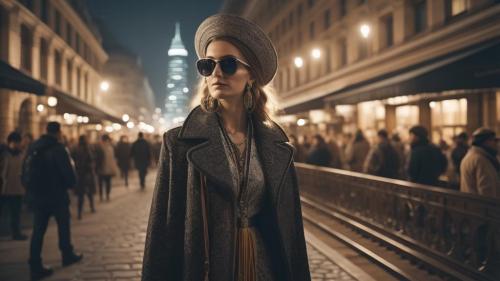Fashion's underground music influence: when beats dictate style

In the dynamic world of fashion and music, there's an evolving trend where underground music scenes shape contemporary style movements. As fashion and music are inherently tied to self-expression, the blend of these two spheres is not entirely new, but the manner in which underground music transforms fashion is a narrative that is intensely captivating.
Exploring the landscapes of music festivals, niche concerts, and pop-up markets reveals a unique intersection of beats and threads. These spaces are not just about music; they are a vibrant display of individuality and creativity. When individuals immerse themselves in underground music culture, they adopt and adapt styles that resonate with the music they love. From distressed fabrics and oversized silhouettes to neon accessories and grunge aesthetics, music genres like techno, punk, and indie have had significant impacts.
Take, for instance, the resurgence of '90s rave culture within fashion. Acid house and techno scenes in urban venues have reinvigorated fluorescent patterns and camo prints. The unity and sense of belonging often felt within these music platforms translate into cohesive and curated fashion statements. Designers draw inspiration from these unconventional beauty ideals, showcasing them on runways and in collections that challenge the norm.
Furthermore, fashion influencers playing DJs or collaborating with underground music artists amplify this trend. These dual personas elevate the influence and ensure it reaches a wider audience, both on social media and in physical gatherings. One can't help but notice how many streetwear brands derive inspiration from underground club culture, directly borrowing elements like bold graphics, futuristic cuts, and eccentric combinations.
As fashion publications such as Vogue and Dazed depict, there's an echo from the underground that reverberates through mainstream style channels. Musicians and designers collaborate more than ever, leading to innovative projects that not only make headlines but also create cultural shifts. Through these partnerships, fashion houses obtain an authentic slice of subculture, while musicians gain a visually compelling stage for their artistic expression.
Moreover, as traditional lines blur between the runway and real life, music-driven fashion explores new spaces, like global fashion festivals and cross-continental collaborations that bring diverse cultures to the forefront of style innovation. These global narratives contribute to more inclusive and eclectic fashion, ensuring that the stories told through fashion are as rich and diverse as the music that inspires them.
What stands out in this fashionable mosaic is the mutual respect and admiration between the industries. When designers authentically embrace and represent the ethos of a music subculture, it results in honest creation rather than mere trend appropriation. This genuine approach not only honors the essence of underground music but also ensures its longevity within the fashion narrative.
To conclude, fashion’s rapport with underground music goes beyond aesthetics; it's a dialogue of values, a fusion of creative realms that continues to redefine cultural boundaries. The heartbeat of underground music pulses through fashion, providing a unique rhythm that resonates globally. As these two creative powerhouses continue their dance, they challenge, redefine, and inspire, opening new horizons in both knowledge and style.
Exploring the landscapes of music festivals, niche concerts, and pop-up markets reveals a unique intersection of beats and threads. These spaces are not just about music; they are a vibrant display of individuality and creativity. When individuals immerse themselves in underground music culture, they adopt and adapt styles that resonate with the music they love. From distressed fabrics and oversized silhouettes to neon accessories and grunge aesthetics, music genres like techno, punk, and indie have had significant impacts.
Take, for instance, the resurgence of '90s rave culture within fashion. Acid house and techno scenes in urban venues have reinvigorated fluorescent patterns and camo prints. The unity and sense of belonging often felt within these music platforms translate into cohesive and curated fashion statements. Designers draw inspiration from these unconventional beauty ideals, showcasing them on runways and in collections that challenge the norm.
Furthermore, fashion influencers playing DJs or collaborating with underground music artists amplify this trend. These dual personas elevate the influence and ensure it reaches a wider audience, both on social media and in physical gatherings. One can't help but notice how many streetwear brands derive inspiration from underground club culture, directly borrowing elements like bold graphics, futuristic cuts, and eccentric combinations.
As fashion publications such as Vogue and Dazed depict, there's an echo from the underground that reverberates through mainstream style channels. Musicians and designers collaborate more than ever, leading to innovative projects that not only make headlines but also create cultural shifts. Through these partnerships, fashion houses obtain an authentic slice of subculture, while musicians gain a visually compelling stage for their artistic expression.
Moreover, as traditional lines blur between the runway and real life, music-driven fashion explores new spaces, like global fashion festivals and cross-continental collaborations that bring diverse cultures to the forefront of style innovation. These global narratives contribute to more inclusive and eclectic fashion, ensuring that the stories told through fashion are as rich and diverse as the music that inspires them.
What stands out in this fashionable mosaic is the mutual respect and admiration between the industries. When designers authentically embrace and represent the ethos of a music subculture, it results in honest creation rather than mere trend appropriation. This genuine approach not only honors the essence of underground music but also ensures its longevity within the fashion narrative.
To conclude, fashion’s rapport with underground music goes beyond aesthetics; it's a dialogue of values, a fusion of creative realms that continues to redefine cultural boundaries. The heartbeat of underground music pulses through fashion, providing a unique rhythm that resonates globally. As these two creative powerhouses continue their dance, they challenge, redefine, and inspire, opening new horizons in both knowledge and style.